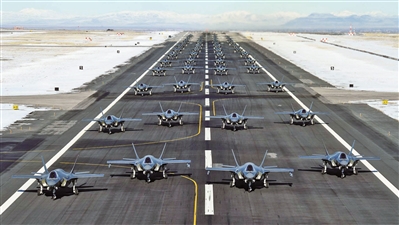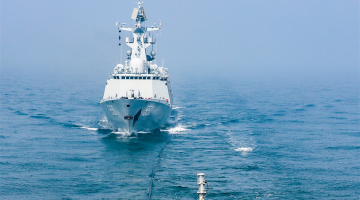
By Hu Xiaodao
The US Department of Defense (DoD) announced the USAF’s F-35 combat exercise on January 6, during which all 52 F-35 jet fighters of USAF’s 388th and 419th Fighter Wings at the Hill Air Force Base in the State of Utah took off at the same time. It is concluded by the DoD that the 388th Fighter Wing at Hill Air Force Base has achieved full war-fighting capability.
As the US-Iran conflict keeps escalating, the US military has been flexing its muscles intensely to release strong signals of deterrence, which has captured extensive attention. Given the recent movements in the international community and the progress on F-35’s commissioning, the US military’s muscle-flexing moves are based on three considerations.
First, the US military tries to change the negative image of F-35. The F-35 jet fighter has been widely criticized for its high price, poor performance and the possibility of information leak since it was debuted. The US claiming on such a high profile the full combat capability of its first F-35 Fighter Wing aimed to enhance people’s confidence in the fighter’s performance and save its reputation to some extent.
Second, the US military attempts to advance the global deployments of F-35. Lately Turkey has almost abandoned the agreement to buy 100 F-35 jet fighters from the US, which lent a blow to the latter’s global deployments of the F-35 combat system. By demonstrating the fighter jet’s conditions, ground support capability, commanding and combat capability, the US military wants to show its allies F-35’s outstanding system and advance its global combat system.
Third, the US wants to intensify the strategic deterrence against Iran. The official announcement from the Pentagon came at a tricky moment considering the all-round tension between the US and Iran, and the photo of so many F-35 fighters in “elephant walk”—the term for military planes taxiing in close formation just before takeoff- at the Hill Air Force Base was obviously aimed to intensify the strategic deterrence against Iran. Some of the air, ground, commanding and supportive personnel at the air force base were deployed to the Middle East last year, and the fully war-ready fighter squadron has been deployed to UAE’s al-Dhafra Air Base, ready to carry out “emergency tasks” in the region anytime.
However, although the first F-35 Fighter Wing has achieved full war-fighting capability, its path of development remains a long and hard journey strewn with various tests.
There is the test of “realistic combat”. If the Trump administration decided to launch military attacks on Iran, the USAF’s F-35 fighters stationed at UAE’s al-Dhafra Air Base might be mobilized as “vanguards”, and their performance would be the basis to evaluate their combat capability.
There is the test of “multi-purpose performance”. The US military has high hopes for F-35 and plans to assign it with more new-type combat tasks in addition to the regular combined air battle, surface battle and ground assault. It even plans to equip the fighter jet with anti-missile capability before 2025, but whether F-35 will be able to carry out these new tasks effectively remains to be observed.
Last but not least, there is the test of “integration”. According to the plan, the US military will strongly promote the F-35 global combat system by way of frontline deployments, selling the fighter jet to other countries, joint exercise and training, and real combats. But there are concerns that the F-35 is not compatible with the combat systems of American allies yet, and sustained explorations and efforts have to be made in order to integrate them seamlessly in the future.









